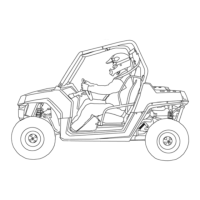5 - 25 ELECTRICAL
GEM Service Manual November 2007
TESTING FOR DEFECTIVE CELLS
During a discharge, all cells in a battery set should
discharge at the same rate. If one or more of the
cells decrease at a faster rate, the total discharge
time may indicate an unacceptable result.
Therefore, the individual batteries must be
compared against the others to see if one or more
of the units need to be replaced.
1. After discharge unit has shut down from
previous test, start unit again.
2. Take voltage measurements across each
battery while the discharger is running.
3. If one or two of the batteries differ in voltage
from the other(s) by more than 0.5 volts,
replace the ones with low voltages.
4. Turn discharge unit off.
EXAMPLE:
• Battery 1: 11.0 volts
• Battery 2: 10.2 volts
• Battery 3: 10.3 volts
• Replace Batteries 2 and 3.
NOTE: Unless the batteries are relatively new
(less than 6 months old), replace with batteries
of similar age and usage.
NOTE: Be sure to charge batteries after
completing the discharge test. Leaving
batteries in a discharged state causes sulfating
to occur which will reduce the life of the
batteries.
WATERING
NOTE: This applies to flooded batteries only.
"Flooded,” means water base batteries.
Flooded batteries need water. More importantly,
watering must be done at the right time and in the
right amount or else the battery's performance and
longevity suffers. Water should always be added
after fully charging the battery. Prior to charging,
there should be enough electrolytes to cover the
plates. If the battery has been discharged (partially
or fully), the electrolyte level should also be above
the plates. Keeping the electrolyte at the correct
level after a full charge will prevent having to worry
about the level at other state of charge. Depending
on the local climate, charging methods, application,
etc. GEM recommends that batteries be checked
once a month until you get a feel for how "thirsty"
your batteries are.
WARNING: THE ELECTROLYTE IS A SOLUTION
OF ACID AND WATER. SKIN CONTACT
SHOULD BE AVOIDED.
IMPORTANT THINGS TO REMEMBER:
1. Do not let the plates get exposed to air. This will
damage (corrode) the plates.
2. The electrolyte level should not be up inside the
fill well. This may cause the battery to over-flow
electrolyte during charging, resulting in a loss of
capacity as well as causing a corrosive mess.
3. Do not use water with a high mineral content.
4. Use distilled or de-ionized water only.
STEP-BY-STEP WATERING PROCEDURE:
1. Remove the vent caps and look inside the fill
wells.
2. Check electrolyte level; the minimum level is at
the top of the plates.
3. If necessary add just enough water to cover the
plates at this time.
4. Replace and tighten all vent caps.
5. Put the battery on a complete charge before
adding any additional water. See Charging in
this section.
6. Once charging is completed, remove the vent
caps and look inside the fill wells.
7. Add water until the electrolyte level is about 1/8"
below the bottom of the fill well.
8. Clean, replace, and tighten all vent caps.

